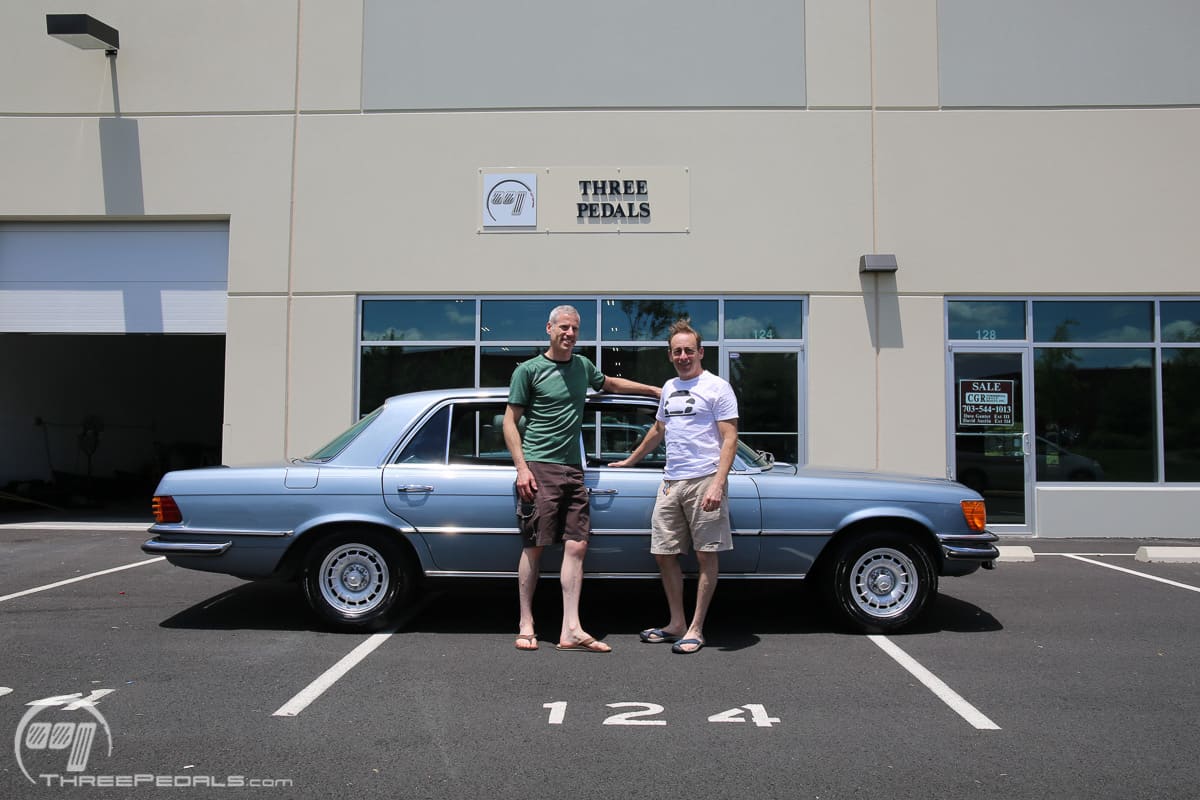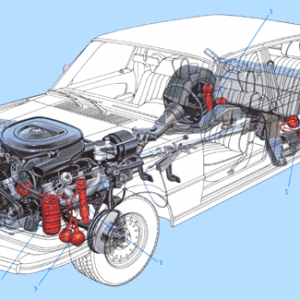When talented engineers stuff the biggest engine they can into a sedately styled sedan and then toss in a high tech suspension system you can bet that it gets our attention – enter the Mercedes Benz 6.9. As in, 6.9 liters (417 cubic inches) of Stuttgart v8. The 6.9 may just be one of the greatest cars you’ve never heard of, and this is the story of the Three Pedals Mercedes 6.9.
Pictured above is our President, Josh Korsower, and Chief Operating Officer, Seth Potack. Born as cousins and brought closer by a love of automobiles, the 6.9 shares a special place in their hearts. Josh’s dad, “Uncle Jack” to Seth, had a 6.9 back in the day and Josh and Seth knew they had to have one at some point. After searching for the same color combo Jack had – light blue over dark blue interior – they found just the right car up for auction at Bring a Trailer.
A little background on the 6.9: At the time of its introduction it was the fastest production four door sedan in the world. 7,380 were built between 1975 and 1981, of which 1,816 were sold in the US. Based on the W116 platform, which included the 450 SE and 450 SEL sedans among others, the 6.9 was based on the longer wheelbase SEL variant, and added the M-100 engine and hydropneumatic self-leveling suspension system. The former is a beast, and the latter is awesome when in tip top shape, but alas expensive to keep in tip top shape. And for the trivia nerds out there – the W116 line was the first Mercedes to be called “S-Class”, short for “Special Class”, translated from the German Sonderklasse.
In the July 1977 issue of Car and Driver, David E. Davis Jr. wrote lovingly of the 6.9, summing it up with:
“How does it all work? Superbly. The 6.9 feels more nimble, more agile than any other Mercedes we can remember. The new suspension, combined with the extra power of the 417-cubic inch engine makes it possible to toss the big sedan around like a bug-eye Sprite.”
Now, on to the M-100 engine, which is a cast iron V8 with single overhead camshafts. Inside the block are forged items – crankshaft, connecting rods, and pistons – heady stuff even today. The oiling system is a “dry sump” setup, which is what race cars and some pretty extreme street cars use, including all Porsche 911s and the top of the range Corvette engines built in this century (LS7, LS9, and LT4 engines). Most street vehicles use a wet sump system, which is prone to oil-starvation during extreme driving, for example when driving at speed on a long curve where centrifugal forces draw the oil to one side of the wet sump pan, in turn starving the oil pump of oil (like starving a human heart of blood, this is not good).
To illustrate the difference between wet sump and dry sump, pour a little bit of your favorite drink into a glass, and now tip the glass to the side a little bit. Using a straw in the center of the glass you’ll find that your straw doesn’t quite get any drink the more you tilt the glass. Dry sump systems don’t suffer from this malady, so any street car with a factory dry sump system is “bad ass” in our book. And since you’re on our website, we assume you share the same view. Note that at the time, the 6.9 was the only production sedan in the US utilizing a dry sump engine. And at oil change time, you’ll need 12.7 quarts of oil, about double what normal wet sump engines hold.
In Europe, the 6.9s were rated at 286 HP and 405 lb/ft of torque. American 6.9s like ours (though we have European headlights and bumpers fitted, it is indeed an American spec car – more on this later) are rated at 250 HP and 360 lb/ft of torque thanks to the stiffer emissions standards in place at the time. All 6.9s run Bosch K-Jetronic electromechanical fuel injection.
All 6.9s feature a 3 speed automatic transmission and a 2.65:1 rear axle ratio. Which means that off the line, the 6.9 does not behave like a muscle car. But once it gets up to speed, lookout – going from 40 to 70 MPH is far more impressive than going from 0 to 30 MPH. As you may have guessed, we do have a fix in mind for this aspect – more on this later. In the meantime, its 140 MPH top speed isn’t too shabby.
So why is the 6.9 relatively unheard of? We think the main reason is that every 6.9 out in the wild is purposefully subtle in appearance – the exterior offers few visual clues to differentiate it from the far more common 450 SEL. Among the clues, the 6.9 badge on the trunk lid is the most obvious, but some owners (like Jack) removed the badge, creating a true sleeper. 1″ wider wheels are less obvious, and of course they allow for wider tires. If you’re up close, if the VIN starts with “116036” then you know it’s a 6.9, with the “036” portion confirming that. Inside, North American 6.9s features a burled walnut dash to set it apart, as well as automatic climate control which was otherwise an option.
Now that you know about the 6.9 you’ll recognize it in the awesome chase scene in the movie Ronin. And it is widely believed that Claude Lelouche’s very short film C’était un rendez-vous was filmed by mounting a camera to the front of a 6.9 as it navigated the streets of Paris at high speed, though the engine sound from a Ferrari was dubbed in for greater effect as the 6.9 is relatively quiet.
Further demonstrating the love of the 6.9, Classic & Sports Car magazine ranked it as fourth overall in the “world’s greatest saloon” listing published in April 1999.
And last but not least, thanks to The International M-100 Group for sharing Brock Yates’s review of the 6.9, published in the 1970’s.
Stay tuned as we continue to baby our baby.










